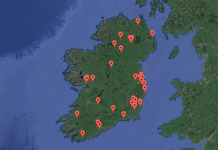 The developer: a vision of the future for the housing industry
The developer: a vision of the future for the housing industry
With decades of successful activity, the Bennett Group of Companies has established itself as a market leader in the construction sector. It’s house construction arm, Michael Bennett & Sons, has been able, over time, to maintain a connection with the market while keeping an eye to the future, and made sustainability one of its major strengths. A member of the Passive House Association of Ireland (PHAI), this Wexford-based company made its commitment to the Passive House standard with the Grange Lough housing development in Rosslare Strand back in 2010, while its first low energy building is dated 2007. Their latest endeavour is the Madeira Oaks Passive House Project based in Enniscorthy, Co. Wexford. This is a 12 unit low energy residential development, fully compliant with the Passive House (PH) Standard and achieving the Near Zero Energy Building (nZEB) requirement. Innovative research was conducted over a period of two years by a team of qualified experts, charged with delivering the best sustainable and affordable solution to the Irish market.
Michael Bennett & Sons accepted the challenge of demonstrating that the building sector going passive is not only possible, but also can be at ‘non-passive’ market cost, whilst simultaneously providing exceptional comfort and quality construction.
The development: passive house accessible to everyone
Project Overview: The Development
The Madeira Oaks Estate consists of 12 units of 3 bedrooms, 2 stories semi-detached houses, each with a floor area of 102m2 (1,100 sq. ft.). The development is located in Enniscorthy, Co. Wexford, and it’s one of a kind in the region. Each pair of dwellings were completed after 13 weeks of construction work, quality, and structural testing, and are fully Passive House certified. The market price of the units amounted to € 183,300.00 each, even though the starting price was set to € 170,000.00.
Energy efficiency and solar power: Passive House reaching nZEB
 Madeira Oaks is a low-energy residential development. The Building Energy Rating (BER) of the units corresponds to a A-class. A-rated homes are the most energy efficient houses and they are the closest to the “zero energy” and “zero emission” principle. The A rating for Madeira Oaks apartments was possible due to the compliance with the Passive House Standard, based on high levels of insulation and rigorous attention to the building envelope. The external walls of each dwelling are constructed of timber frame and are protected by an external brickwork/rendered blockwork leaf which is separated from the timber frame by a ventilated cavity, and uP.V.C triple glazed windows and doors are used throughout. The ground floor slab and roof (making up the remaining elements of the thermal envelope) also contain very high levels of insulation, which combine with very good airtightness values (average 0.30ACH) to minimize heat loss. Together with a mechanical heat recovery ventilation system, a tailored design maximises passive solar gain, and makes a significant contribution to keeping the house at a constant temperature of 20-21 degree Celsius. The (small) heat demand is supplied by the MHRV Unit, as it contains a small heat pump that can be utilized to heat the incoming fresh air (if required) through the supply air ducting system. At Madeira Oaks, each house has been designed to include an array of photovoltaic panels. At Madeira Oaks space and water heating are provided by a Nilan Compact P, a modular compact system that combines an air heat pump with a heat recovery unit, supplying the heating, cooling, ventilation and hot water needs at an estimated cost of €200 a year. The additional of photovoltaic panels though, will be able to supply energy for the same amount of money, resulting in net zero heating and water costs for Madeira’s homeowners.
Madeira Oaks is a low-energy residential development. The Building Energy Rating (BER) of the units corresponds to a A-class. A-rated homes are the most energy efficient houses and they are the closest to the “zero energy” and “zero emission” principle. The A rating for Madeira Oaks apartments was possible due to the compliance with the Passive House Standard, based on high levels of insulation and rigorous attention to the building envelope. The external walls of each dwelling are constructed of timber frame and are protected by an external brickwork/rendered blockwork leaf which is separated from the timber frame by a ventilated cavity, and uP.V.C triple glazed windows and doors are used throughout. The ground floor slab and roof (making up the remaining elements of the thermal envelope) also contain very high levels of insulation, which combine with very good airtightness values (average 0.30ACH) to minimize heat loss. Together with a mechanical heat recovery ventilation system, a tailored design maximises passive solar gain, and makes a significant contribution to keeping the house at a constant temperature of 20-21 degree Celsius. The (small) heat demand is supplied by the MHRV Unit, as it contains a small heat pump that can be utilized to heat the incoming fresh air (if required) through the supply air ducting system. At Madeira Oaks, each house has been designed to include an array of photovoltaic panels. At Madeira Oaks space and water heating are provided by a Nilan Compact P, a modular compact system that combines an air heat pump with a heat recovery unit, supplying the heating, cooling, ventilation and hot water needs at an estimated cost of €200 a year. The additional of photovoltaic panels though, will be able to supply energy for the same amount of money, resulting in net zero heating and water costs for Madeira’s homeowners.
The high performance of the Passivhaus design makes possible for the Madeira’s buildings to meet the nZEB parameters. Shane Colclough, researcher at the Centre for Sustainable Technology in Ulster University and PHAI director, recently released a report based on the monitoring of one of Bennett’s dwellings. The monitoring activity registered the values of primary energy consumption, carbon dioxide emissions, Energy Performance Coefficient (EPC), Carbon Performance Coefficient (CPC), revealing that while the house is designed to meet the Passive House standard, it is also able to achieve nZEB. As described in the report, the analysis is based on a 103 m² certified Passive House home occupied by one person. Space heating, domestic hot water, ventilation and cooling needs are addressed by an exhaust air heat pump and a heat recovery unit. The house uses only electricity as its energy source (which could be form renewable sources). Given that Passivhaus and nZEB buildings are designed through different software (respectively PHPP and DEAP), Dr Colclough had to adapt PHPP to perform calculations on the same basis as the DEAP software. The results of this comparison can be viewed in Table 1.
 Table 1: Typical performance standards for nZEB dwellings. Source: Colclough, S., 2017
Table 1: Typical performance standards for nZEB dwellings. Source: Colclough, S., 2017
The values exhibited in Table 1 clearly show that, while complying with the Passivhaus Standard, the sample dwelling is compliant with the nZEB requirements as well. Colclough’s research on Madeira Oaks proves that quality products, expert workmanship and a rigorous application of the Passive House method is the easiest and most cost-effective way to achieve Near Zero Energy Building (nZEB) and ultimately Zero Energy.
Household experience: best comfort at affordable price
Beyond the remarkable energy savings, another primary requirement is that a house must create a sense of wellbeing in terms of household comfort. This project intends to provide not only an affordable and sustainable solution, but also the highest comfort levels for potential owners. With a highly draught proof envelope, a constant temperature of 21°C, and an efficient ventilation system supplying a steady stream of fresh air, comfort is assured in the Madeira Oaks’ dwellings. The air supplied into the house is constantly filtered and tempered to remove excess moisture, and is changed at the rate of eight complete air changes per day. As a result, the air is always at the correct temperature, humidity level, and contains copious amounts of oxygen. These houses will never be ‘stuffy’: all the problems associated with traditional, poor quality construction have vanished. The development demonstrates that these passive houses are in fact actively taking care of the homeowners needs and comfort, looking after the family’s well-being in a healthy living environment. They are also very sound proof, because of the amount of insulation making up the thermal envelope, and the triple glazed windows and doors. The party wall separating each pair of houses achieved a sound reduction factor two and a half times the minimum building regulations standard.
Madeira Oaks dwellings’ performance left many astonished and delighted. The homeowners now have a daily direct experience of what living in a passive house means. The buyers have their first experience with passive houses, and have been previously been living in traditional buildings full of drafts and discomfort. Interviewed by the Passive House Plus Magazine, the homeowners noted that it was now difficult for them to tell what’s the climate was like outside the house, once they are used to the comfort levels and constant temperatures of their passive house. A householder revealed that while she found it hard to heat up her previous home, the only reason now why she lights the stove is because she enjoys the look of the fire. All the buyers found it astonishing how low their energy bills were.
Cost efficiency: a payback investment
The benefits of Madeira Oaks development consist of meeting households’ needs not only with regard to the highest comfort standards, but also enabling significant savings on energy consumptions and related expenses, over the long-term. One of the major benefits of Passive House technology and building standard are low running costs. The annual average expense for space and water heating in one of the Bennett and Sons’ passive house have been calculated as €200, which is converted into thousands of euro of savings over a full year, compared to a conventional house of similar size. The savings can then be used by the homeowner to pay property tax and water charges, or even part of a mortgage. This saving is also recognised as a major factor and solution to fuel poverty for low income families, as when living in a passive house the percentage of income required for purchasing energy is miniscule.
The low price makes Madeira Oaks the ideal settlement for first time buyers, who can enjoy the best comfort benefits at affordable prices. As reported by the PH+ Magazine, this is the first time that houses build to this standard are being offered to the market as affordable, both from the initial cost point of view, and low running cost. The starting price of € 170,000.00 didn’t allow the builder a great margin of profit, but the low launching price was mainly to dispel a false myth of the cost of passive house build. It is commonly believed that passive houses come at a much higher price compared to regular buildings, for all the parties involved in the construction process and for the buyer. What Michael Bennett and his team wanted to prove, is that this misconception is simply not true. Everyone deserves to live in a comfortable, healthy, high quality, efficient house, and Passivhaus makes it possible.
Conclusion
Madeira Oaks dwellings’ performance left many astonished and delighted. The homeowners, for the ultra-low costs of energy bills; one professional sound tester found out that the sound insulation performance is comparable to the set parameters for commercial cinemas; experts and professionals in the field, for the incredible cost efficiency of the project. The success of the whole development and of Passivhaus per se, had such a great resonance that Wexford County Council decided to be involved, within the framework of its social housing scheme.
Madeira Oaks was a successful investment that proved the efficiency and feasibility of passive house, and we expect to see many more of these developments to spread across the country in the near future, for the benefit of entire communities.

Appendix: Technical Specifications
Insulation
External Walls: 100mm thick external block outer leaf, 50mm thick service cavity, and an insulated timber frame inner leaf (190mm cellulose, toxin free insulation. U value= 0.16 W/m2 K.
Roof: Selected concrete tiles with matching ridge tiles on treated battens on sarking felt on pre-fabricated roof trusses on treated swd. wall plate. PVC fascia and soffit, gutters and downpipes throughout. Insulation laid between ceiling joist. Roof U value= 0.07 W/m2 K.
Ground Floor and First Floor: 150mm power floated concrete slab floor on polystyrene insulation under entire slab and upturned at edges on 1200 gauge visqueen d.p.m., on 225mm min. well compacted and blinded hardcore. Ground floor U value= 0.07 W/m2 K.
Air tightness
Walls airtight board and airtight membrane. Air permeability= 0.3 m3/hr m2 @ 50 Pascal.
Thermal bridging
All connection points where thermal bridges normally occur have been detailed so that there is zero thermal bridging throughout each house.
Windows and Joinery
Triple glazed uP.V.C. windows. External doors and frames are uP.V.C. Air tight attic hatch. Window U value= 0.74 W/m2 K.
Heating System & Ventilation
The houses have supplementary space heating through the MHRV Unit’s small heat pump, in conjunction with a mechanical heat recovery ventilation system (heat recovery efficiency= 84%), hot water generation, and roof mounted photovoltaic (PV) panels. Predicted electrical generation= 1025 kWh/year.



















